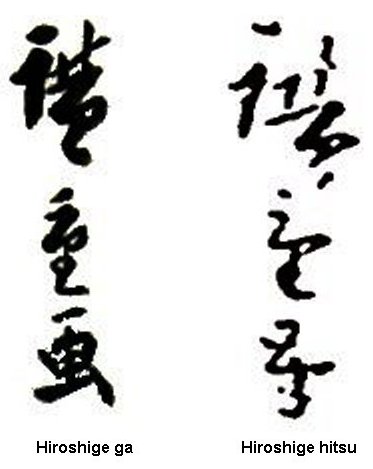| |
HIROSHIGE IIISHIGEMASA
|
|
| HIROSHIGE III
(SHIGEMASA) Signatures |
Artist - HIROSHIGE-III (三代目 歌川 広重 San-daime
Utagawa HIROSHIGE), 1842–1894) was a Japanese designer of
ukiyo-e art. He was was a student of Utagawa HIROSHIGE (I), and
a fellow student of SHIGENOBU, now commonly known as HIROSHIGE
II. SHIGEMASA inherited his master's "go" name "HIROSHIGE" after
HIROSHIGE-II (SHIGENOBU) divorced from HIROSHIGE (I)'s daughter,
and left the school in 1865. HIROSHIGE-III (SHIGEMASA) is now
usually referred to as "HIROSHIGE-III". Hiroshige III worked in
the same artistic style as his master, but did not achieve
anywhere near the same level of success. Reportedly his first
work was the illustration of the ninth volume of the e-hon
(picture book) "Edo miyage" (Picture-book of Edo Souvenirs,
1864). Like his predecessors, HIROSHIGE-III designed several
woodblock print series, namely
Nishiki-e - During Meiji-era, there was a strong demand for the news media to distribute images of unfamiliar and foreign things or events. Responding to such needs, new "nishiki-e" ("Newspaper nishiki-e", "新聞錦絵", shinbun nishiki-e) played an important role in reporting and disseminating novelties to people nationwide. During these years, many journalistic new "nishiki-e" were published, and the new Meiji government utilized "nishiki-e" for educational purposes in the process of building a nation. One of the core print series was the "Dai Nippon Bussan Zue" (The Greater Japan Products), mostly drawn by HIROSHIGE III, using his artist's name "Andō Tokubei" in close cooperation to the publisher Ōkura Magobei.
Personal life -Born Gotō Torakichi (後藤寅吉) in 1842 in Fukagawa in the Eastern part of Edo and that he died in 1894. His father was a carpenter, but he was adopted by the restaurant owner named Ryotei. He used the family name Andō Tokubei 安藤 徳兵衛 (安藤徳兵エ). He became a student of Utagawa HIROSHIGE (I) in his mid-teens, and was given the artistic name SHIGEMASA. He is thought to be the last disciple of HIROSHIGE (I). In 1867, after HIROSHIGE II, a fellow pupil of the original HIROSHIGE (I), divorced the master's daughter Oyatzu (Otatsu or Tatzu), Andō Tokubei ((SHIGEMASA) married her and initially after the marriage took on the name HIROSHIGE (II) as well. By 1869 he began calling himself Hiroshige III.
Aliases - Gotō Torakichi (後藤寅吉), Shigemasa (重政), auch Hiromasa (広政), later Hiroshige III. (広重 三代) also signed as Utashige (歌重), also referred to as Andō Tokubei (安藤徳兵).
Disciples - Shōsai Ikkei (昇斎一景), active ca. 1870–75;
- “Famous Places in Tōkai: The Revised 53 Stations,” (Tōkai Meisho Kaisei 53 Eki) of 1876
- He also left many so-called "kaika-e", depicting Western-style buildings and scenes.
- Kokon Tokyo Meisho and
- Pictures of Products and Industries of Japan, the achievements of the new Meiji era, like new steel bridges, modern stone buildings, street cars, steam trains and alike.
Nishiki-e - During Meiji-era, there was a strong demand for the news media to distribute images of unfamiliar and foreign things or events. Responding to such needs, new "nishiki-e" ("Newspaper nishiki-e", "新聞錦絵", shinbun nishiki-e) played an important role in reporting and disseminating novelties to people nationwide. During these years, many journalistic new "nishiki-e" were published, and the new Meiji government utilized "nishiki-e" for educational purposes in the process of building a nation. One of the core print series was the "Dai Nippon Bussan Zue" (The Greater Japan Products), mostly drawn by HIROSHIGE III, using his artist's name "Andō Tokubei" in close cooperation to the publisher Ōkura Magobei.
Personal life -Born Gotō Torakichi (後藤寅吉) in 1842 in Fukagawa in the Eastern part of Edo and that he died in 1894. His father was a carpenter, but he was adopted by the restaurant owner named Ryotei. He used the family name Andō Tokubei 安藤 徳兵衛 (安藤徳兵エ). He became a student of Utagawa HIROSHIGE (I) in his mid-teens, and was given the artistic name SHIGEMASA. He is thought to be the last disciple of HIROSHIGE (I). In 1867, after HIROSHIGE II, a fellow pupil of the original HIROSHIGE (I), divorced the master's daughter Oyatzu (Otatsu or Tatzu), Andō Tokubei ((SHIGEMASA) married her and initially after the marriage took on the name HIROSHIGE (II) as well. By 1869 he began calling himself Hiroshige III.
Aliases - Gotō Torakichi (後藤寅吉), Shigemasa (重政), auch Hiromasa (広政), later Hiroshige III. (広重 三代) also signed as Utashige (歌重), also referred to as Andō Tokubei (安藤徳兵).
Disciples - Shōsai Ikkei (昇斎一景), active ca. 1870–75;
Copyright 2008 ff: Hans P. Boehme
